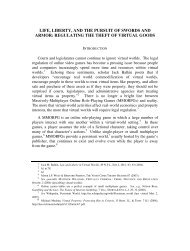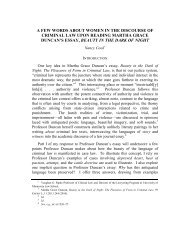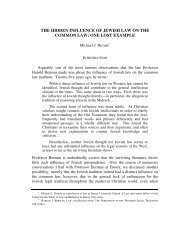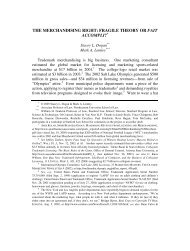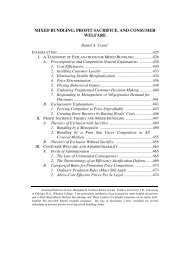Chimera and the Continuum of Humanity - Emory University School ...
Chimera and the Continuum of Humanity - Emory University School ...
Chimera and the Continuum of Humanity - Emory University School ...
Create successful ePaper yourself
Turn your PDF publications into a flip-book with our unique Google optimized e-Paper software.
362 EMORY LAW JOURNAL [Vol. 55<br />
E. Has Congress Taken a Stance on <strong>the</strong> Patentability <strong>of</strong> <strong>Chimera</strong>?<br />
In 2004, Congress passed <strong>and</strong> President Bush signed into law a provision <strong>of</strong><br />
<strong>the</strong> federal budget that prohibits <strong>the</strong> PTO from issuing patents on “human<br />
organisms.” 117 The provision has become widely known as <strong>the</strong> “Weldon<br />
Amendment,” after its author, Representative Dave Weldon <strong>of</strong> Florida. 118 The<br />
Weldon Amendment states that “none <strong>of</strong> <strong>the</strong> funds appropriated or o<strong>the</strong>rwise<br />
made available under this Act may be used to issue patents on claims directed<br />
to or encompassing a human organism.” 119 The Amendment does not directly<br />
alter <strong>the</strong> scope <strong>of</strong> <strong>the</strong> Patent Act, however, since it is only a temporary budget<br />
provision. 120 According to Representative Weldon, <strong>the</strong> intent <strong>of</strong> <strong>the</strong> provision<br />
is, on one h<strong>and</strong>, to codify <strong>the</strong> PTO’s policy that genetically-engineered adult,<br />
fetal, <strong>and</strong> embryonic human organisms are not patentable, but on <strong>the</strong> o<strong>the</strong>r<br />
h<strong>and</strong>, not to affect <strong>the</strong> patentability <strong>of</strong> human DNA sequences, cell lines, stem<br />
cells, <strong>and</strong> o<strong>the</strong>r biological products. 121 Commenting specifically on chimera,<br />
Representative Weldon made it clear that in his view <strong>the</strong> provision does not<br />
affect <strong>the</strong> PTO’s policy on <strong>the</strong> patentability <strong>of</strong> human-animal chimera:<br />
What about an animal that is modified to include a few human genes<br />
so it can produce a human protein or antibody? What about a<br />
human/animal “chimera” (an embryo that is half human, half<br />
animal)? . . . The USPTO has already granted patents on <strong>the</strong> former.<br />
It has also thus far rejected patents on <strong>the</strong> latter, <strong>the</strong> half-human<br />
embryo, because <strong>the</strong> latter can broadly but reasonably be construed<br />
as a human organism. The Weldon amendment does nothing to<br />
change this, but leaves <strong>the</strong> USPTO free to address new or borderline<br />
issues on <strong>the</strong> same case-by-case basis as it already does. 122<br />
While Representative Weldon has stated that <strong>the</strong> provision does not directly<br />
affect <strong>the</strong> present status <strong>of</strong> chimera patentability, <strong>the</strong> American Bar Association<br />
has argued that <strong>the</strong> language <strong>of</strong> <strong>the</strong> enacted provision “confuses <strong>the</strong> situation”<br />
117 Consolidated Appropriations Act <strong>of</strong> 2004, Pub. L. No. 108-199, § 634, 118 Stat. 101; SECTION OF<br />
INTELLECTUAL PROP. LAW, AM. BAR ASS’N, REPORT TO THE HOUSE OF DELEGATES 2 (2004) [hereinafter ABA<br />
REPORT], http://www.abanet.org/leadership/2004/annual/104.doc.<br />
118 See generally ABA REPORT, supra note 117.<br />
119 § 634, 118 Stat. 101. The language <strong>of</strong> <strong>the</strong> provision may not prohibit patents on <strong>the</strong> methods used to<br />
create human organisms, just <strong>the</strong> organisms <strong>the</strong>mselves. On August 24, 2004, <strong>the</strong> PTO issued a methods<br />
patent for cloning mammals that did not exclude human beings from its claims. See U.S. Patent No. 6,781,030<br />
(filed Nov. 2, 1999).<br />
120 See generally ABA REPORT, supra note 117.<br />
121 Kopinski, supra note 6, at 635; Rick Weiss, Hill Negotiators Agree to Bar Patents for Human<br />
Organisms, WASH. POST, Nov. 25, 2003, at A19.<br />
122 149 CONG. REC. E2235 (daily ed. Nov. 5, 2003) (statement <strong>of</strong> Rep. Weldon).





